Since initially joining the club as a youth team coach back in 2016, Marijan Budimir has performed a few different roles at Hajduk Split, including assistant manager for the senior squad. The 42-year-old’s proudest achievements with the Dalmatian club have come during his tenure as U19s boss, a role he’s occupied since 2019.
Hajduk Split U19s didn’t even compete in the top national U19s division back in 2016, Budimir’s first year at the club, as club president Marin Brbić wanted to save money on travel costs, as per Telesport, instead taking part in the local Dalmatian league.
Needless to say, that stance didn’t last too long and since taking charge in 2019, Budimir has guided his club to three straight national ‘Junior’ Championships, demonstrating domestic dominance and the ability of the coach to get the best out of his teams despite the ever-changing nature of the squad available to him at youth level.
Of course, the development of the players is the primary goal at youth level, but success isn’t a bad by-product of that development either, with Budimir having played an instrumental part in the development of the likes of MLS side LAFC’s Stipe Biuk, Dinamo Zagreb’s highly-rated 18-year-old midfielder Marko Brkljača and Austrian Bundesliga side LASK’s Marin Ljubičić just to name a few of those who’ve sat under Budimir’s learning tree thus far.
The self-professed “control freak”, who played for Hajduk Split at youth level before moving to Serie A side Udinese in 2000, has recently guided his team to their furthest-ever point in the UEFA Youth League, helping them reach the Round of 16 — a feat they failed to accomplish last season when they were knocked out of this competition by Atlético Madrid on penalties — where they will play against Manchester City U19s in what should be a fascinating clash between two very exciting young coaches in Budimir and Brian Barry-Murphy, formerly of Rochdale, as well as a face-off between some of Europe’s elite teenagers.
His team’s defensive capability has been key to their progress into the round of 16 in this competition and in this tactical analysis, we aim to provide some insight into Budimir’s approach with Hajduk Split U19s without the ball.
This analysis will look at the strategy and tactics that have resulted in Hajduk Split U19s entering the round of 16 in the UEFA Youth League having conceded just two goals in five games, with a decent 3.44 xGA (15th-lowest of all 48 teams), per Wyscout. Furthermore, their xGA per shot is just 0.104 according to Wyscout — the ninth-lowest in the competition, indicating they’re not giving their opponents a very high chance of scoring per shot.
Budimir’s side has been aggressive and effective with high pressing this term and our tactical analysis will focus on Hajduk Split U19s’ approach to pressing under the admirer of former Chelsea, PSG and Borussia Dortmund boss Thomas Tuchel.
Wide pressing traps
As well as being a Thomas Tuchel admirer, Budimir is said to be guided by the principles of legendary Split-born coach Stanko Poklepović, who said that: “defence must be firmly defined, and the attack undefined and unknown to the opponent.” Naturally, we’re going to focus on the first half of that primarily here as we analyse how Budimir and his team define their defence in the high-block phase.
Their PPDA of 7.0, per Wyscout, is the seventh-lowest PPDA in the 2022/23 UEFA Youth League, telling us they allow their opponents to play quite few passes before committing a defensive action — a direct result of their effective and aggressive high pressure.
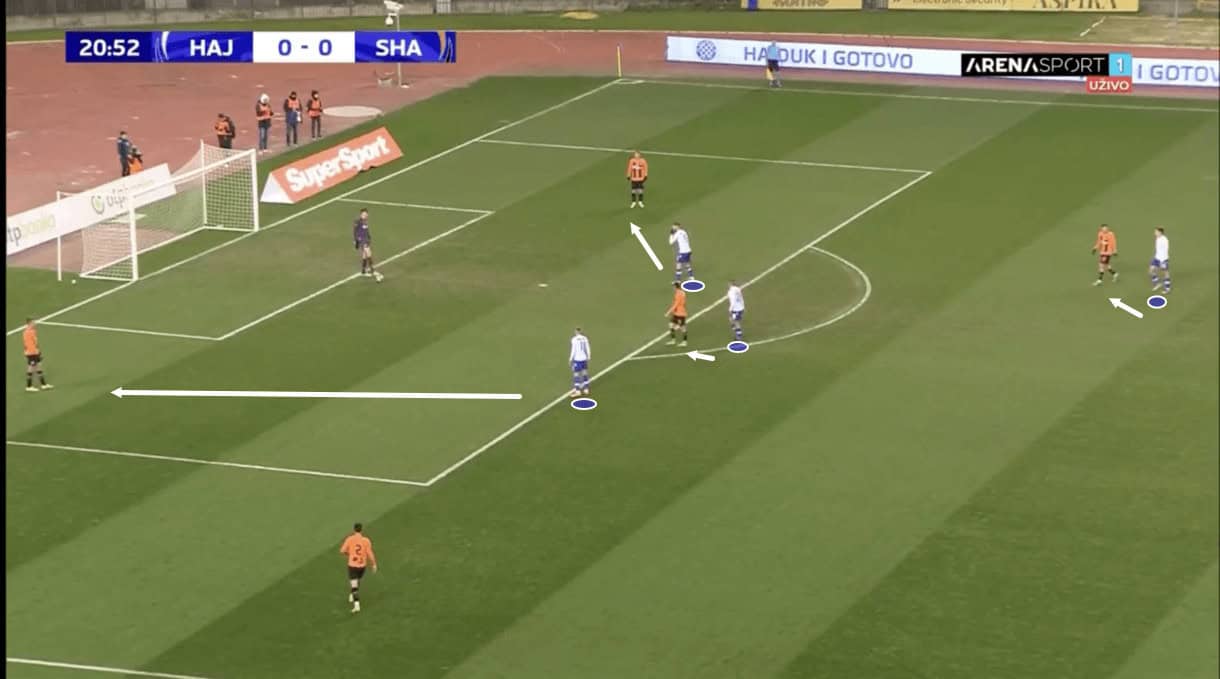
Budimir’s side likes to force the opposition wide in the early stages of their build-up and figures 1-2 will show an example of how they try to achieve this. It’s typical to see Budimir lining his team up in either a 4-2-3-1 or 4-4-2 and in figure 1 above, we can see Budimir’s forwards and central midfielders positioned quite high as the opposition prepare to start their build-up from the goal-kick, with the two forwards split wide to retain easy access to the two centre-backs on either side of the goalkeeper, while one central midfielder has pushed up aggressively to mark the opposition’s holding midfielder.
The purpose of this positioning is to ensure that wherever the ‘keeper goes directly from the goal-kick, should he choose a short option as it appears his team is getting ready for, there’s a Hajduk player nearby ready to close them down aggressively with the aims of making the opposition’s progression as difficult as possible, as early as possible and trying to regain possession as close as possible to the opposition’s goal to create a dangerous goalscoring opportunity as a result.
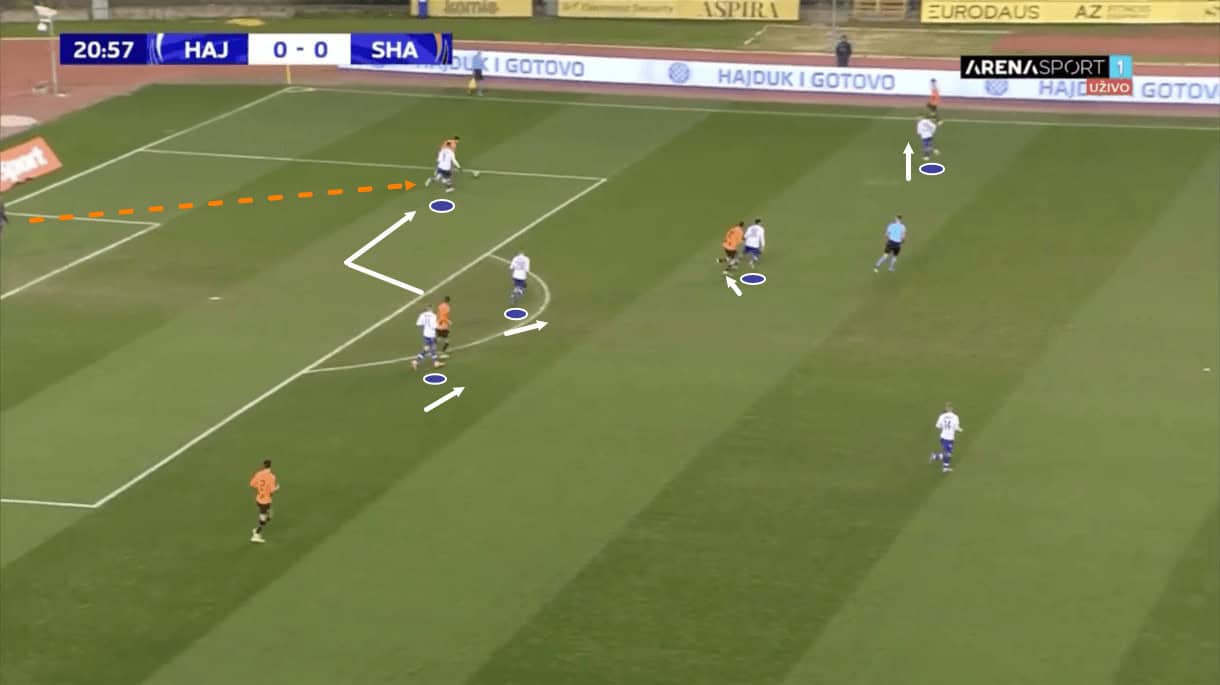
The ball was played out to the left centre-back here and as that pass was made, we see Hajduk’s left centre-forward start dropping back while the right centre-forward presses.
The right centre-forward will not make a beeline straight for the receiver, however. First, he will run forward to cut off the potential switch. Then, when positioned between the ball carrier and his centre-back partner, the centre-forward will close down the ball carrier.
By cutting the pitch in half with this kind of pressing movement, Hajduk significantly limit the opposition ball carrier’s passing options. By pressing from in-to-out, forcing them into a wider area and forcing them to face away from the centre of the pitch, Hajduk further limit the opposition’s passing options.
With the pitch cut in half, Hajduk can get aggressive with their pressing on this side of the pitch, sacrificing coverage on the opposite side. The gamble here is in their belief that they’ve done enough to prevent the opposition from switching the play. Assuming this is correct, they increase their chances of regaining possession a lot because they commit more bodies to this near side where the opposition are pinned down. However, if the switch is possible, then the opposition will have plenty of space on the opposite side to exploit.
They love to use the wings to their advantage when pressing high. Of course, when positioned centrally on the ball, you have a greater field of vision and thus, more viable passing options available. When you’re positioned out wide on the ball, the opposite is true.
This aggressive pressure on the ball carrier combined with the tight marking from the other Hajduk players behind this right centre-forward denies the ball carrier any clear progressive passing options and forces the player into a less controlled long ball. This increases the chances of error from the side in possession, improving Hajduk’s chances of winning the ball back.
Hajduk have made the ninth-most interceptions (43.59 per 90) in the UEFA Youth League this term and their high pressure to deny clear progressive passing options and force these uncontrolled passes from the opposition has played a major part in that.
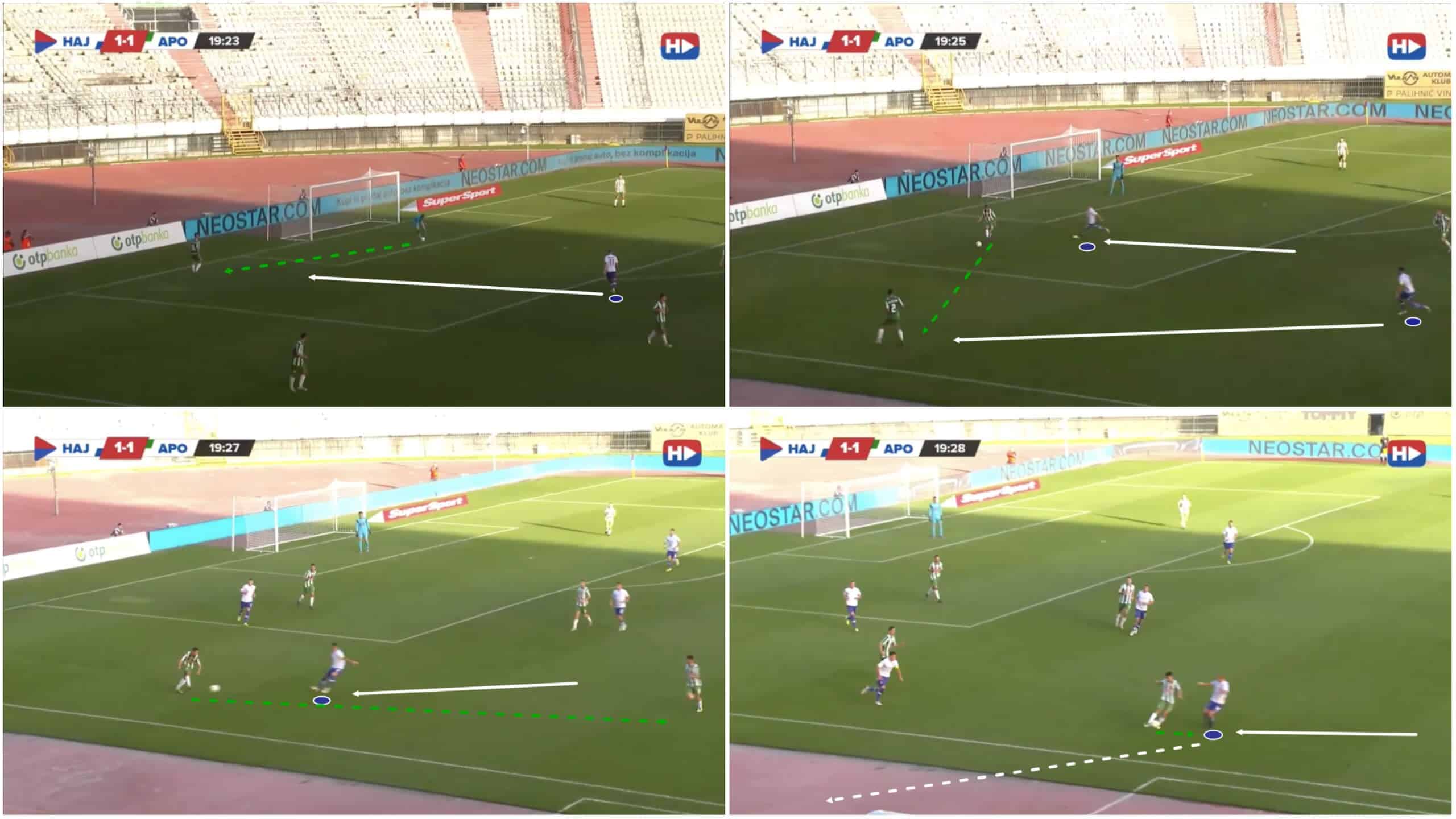
We have a clear example of Hajduk using the wings to their advantage when in the high-block phase here in figure 3. The centre-forwards act similarly here to how they acted in the previous example; this time, the opposition’s right centre-back received the ball, so Hajduk’s left centre-forward stepped up to press. As they did so, Budimir’s side left the pass from the right centre-back to the right-back open. This was intentional — to set up the wide pressing trap.
Hajduk wanted the opposition to play the ball out here because of the limited field of vision and limited passing options available; here, Budimir’s side can use the sideline as an additional defender and comfortably increase their pressing intensity.
From here, all that’s left on for the opponent is this undesirable pass up the wing to another marked man who tries to send the ball upfield but is denied by the pressure from behind, which forces the ball out for a throw-in but denies the opposition progression upfield and could well have resulted in a high regain for Hajduk.
Budimir’s side want to make that pass from the centre-back out to the full-back as attractive as possible. When the ball moves there, they want to cut off any routes back into the centre and close down as aggressively as possible to prevent progression and, if possible, force a turnover.
Centre-forward shadowing
In addition to pressing the centre-backs after they receive the ball and cutting off the switch, an important part of the centre-forwards’ role within this defensive system, at times, is shadowing the opposition’s holding midfielder to ensure the pass can’t be played into the centre from the backline — it depends on the specific approach and tactics for a given game and a given point within a game to determine exactly how Budimir will want his forwards to act and, of course, it’s all relative to the situation.
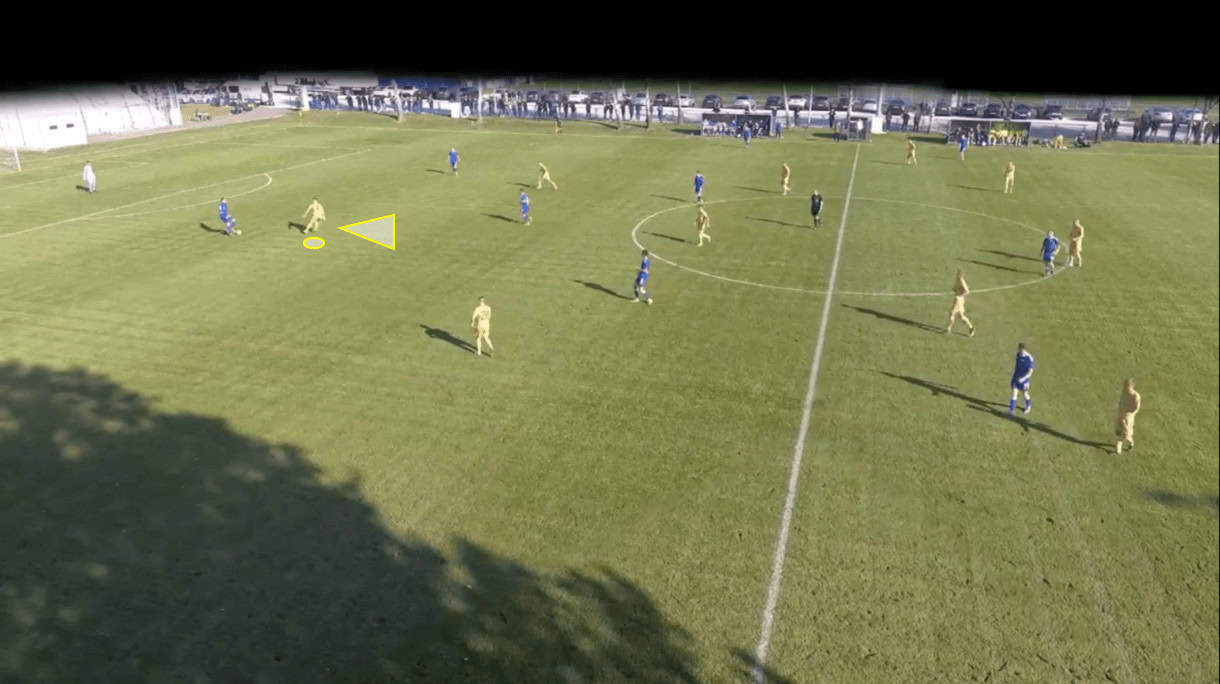
Here in figure 4, we see Hajduk’s left centre-forward keeping the holding midfielder in his cover shadow while the opposition’s right centre-back has the ball at his feet and searches for a way forward. The pass across to his centre-back partner is also quite undesirable because of the Hajduk right centre-forward’s positioning and readiness to press the left centre-back.
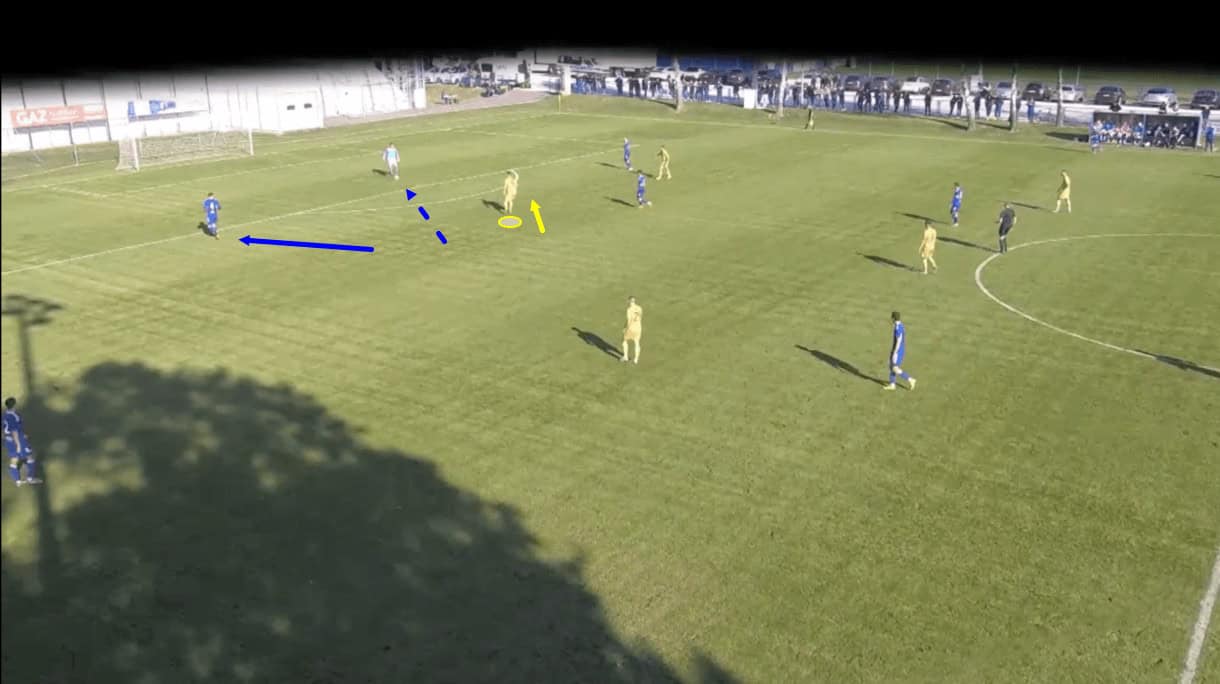
As the ball is played back to the ‘keeper, Hajduk’s left centre-forward stays closer to the holding midfielder than the right centre-back. At this moment, there isn’t a midfielder advanced to cover this holding midfielder as there was in figures 1, 2 and 3; instead, Hajduk are keeping more players covering the deeper positions to prevent the space between the midfield line and backline from being exploited, which can easily happen when you advance the central midfielders into more advanced positions.
The left centre-forward’s priority here is to protect the centre and prevent the furthest forward pass he can and that entails covering the holding midfielder here, leaving the ball to the right centre-back open.
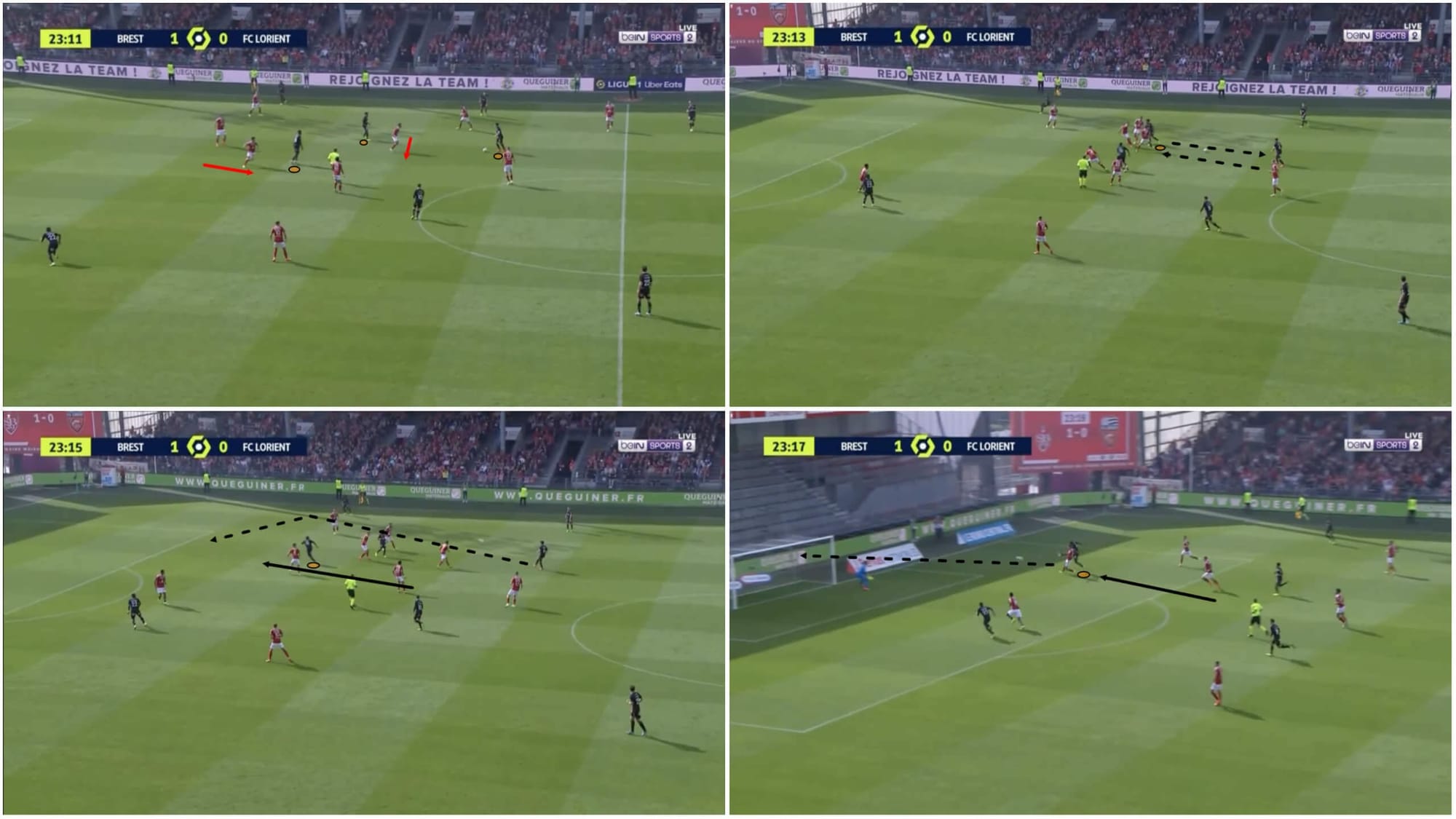
As play moves on into figure 6, we see that after the right centre-back does, in fact, receive the ball back again, he actually manages to find a pathway around the left centre-forward and into the holding midfielder’s feet.
This creates an opportunity for the opposition to progress from a central position, but it’s worth noting that the holding midfielder receives in a box of Hajduk players here too, and while the intention was for the left centre-forward to prevent this pass into midfield and force the play out wide as we know Hajduk typically like to do, it’s very much possible that the receiver in a situation like this could be closed down before playing a good progressive pass for his team, either due to the central midfielder behind him advancing, the wide men closing in on him or the centre-forward tracking back, thanks to the positioning of Hajduk players but it depends on how quickly they can react to the first line being broken.
Again in this passage of play, we see an example of how Hajduk may try to force play into the wide areas, this time focusing on how the centre-forwards shadow the opposition’s holding midfielder, denying the central progression via that avenue while leaving the pass out to the wing open. Unfortunately, however, the opposition did very well to get beyond Hajduk’s first line of defence on this occasion.
Tracking back
Tracking back to help out your deeper teammates after the ball has been played beyond your part of the pitch is another significant element of Hajduk U19s’ pressing approach under Budimir. The 42-year-old coach requires tremendous physical energy and work rate from everybody on the pitch in order to carry out his plans to their maximum effectiveness.
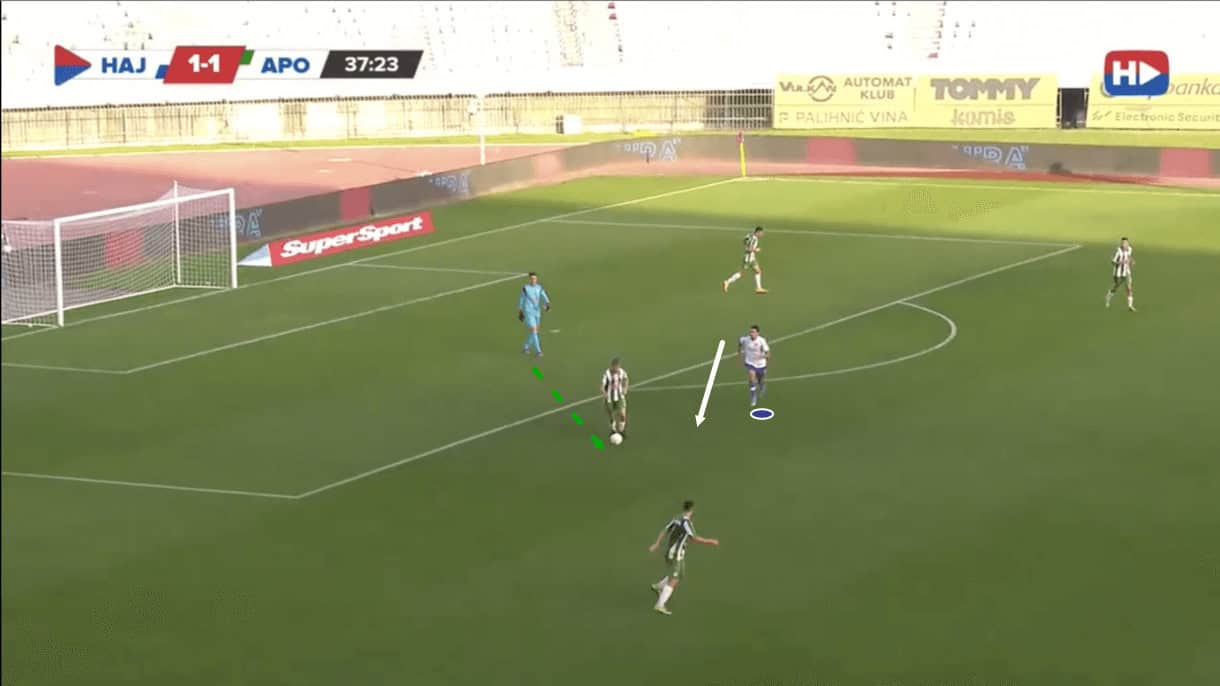
We’ve seen plenty of examples of Hajduk’s forwards, wingers and midfielders carrying out this principle and it’s most evident from Hajduk’s centre-forwards, as they’re the ones who’ll most frequently need to track back, given they’re also the most likely to see the ball go past them, being that they play in the very first line of defence.
Take figure 7, for example; here, the opposition’s right centre-back is moving his side beyond Hajduk’s first line of defence and is about to play the ball to the right-back, who’s actually positioned further forward and more centrally than normal on this occasion.
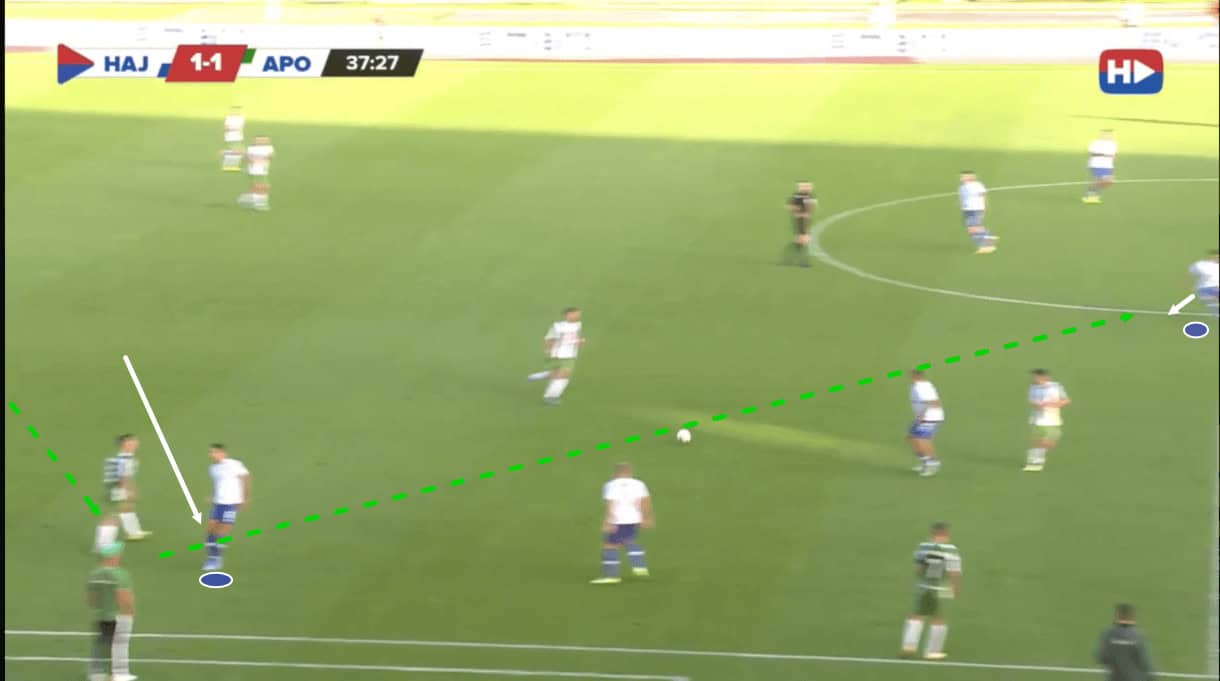
This pass is played and the right-back gets on the ball, but Hajduk’s centre-forward continues tracking back, not taking a second to hesitate or just give up as a result of the ball moving beyond his specific area of the pitch.
Thanks to this mentality and work rate, Budimir’s centre-forward successfully rushes the opposition’s right-back into his next move, forcing an uncontrolled and misdirected pass into midfield that gets easily intercepted by Hajduk’s central midfielder. This gives Budimir’s side a great chance to mount a counterattack from a decent central position.
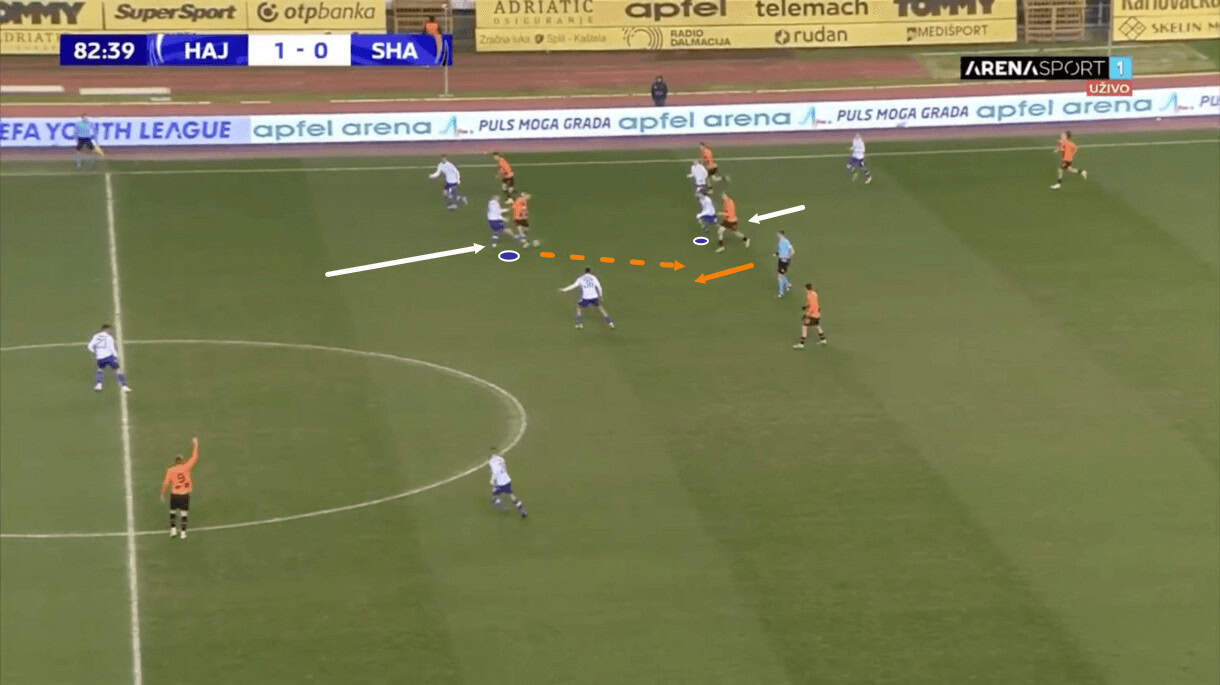
We see another example of the Hajduk centre-forwards tracking back to help out their deeper teammates in figures 9-10, as well as an example of tactical fouling within this team. Hajduk press high, which of course has its risks and as a result, if the ball moves beyond their press and threatens to expose their backline, they may occasionally opt to make a little (non-malicious) foul in a non-threatening area to end the counterattack. It’s not a beautiful tactic but it’s certainly a part of the modern game that we see at all levels of the game, including at the very top.
Hajduk have made 14.84 fouls per 90 this season — ranking them ninth among all 48 UEFA Youth League teams this term for foul frequency and their tactical fouling tendencies undoubtedly play a part in that figure.
In figure 9, we see that the opposition have dragged a Hajduk centre-back out of position, isolating the other centre-back deeper.
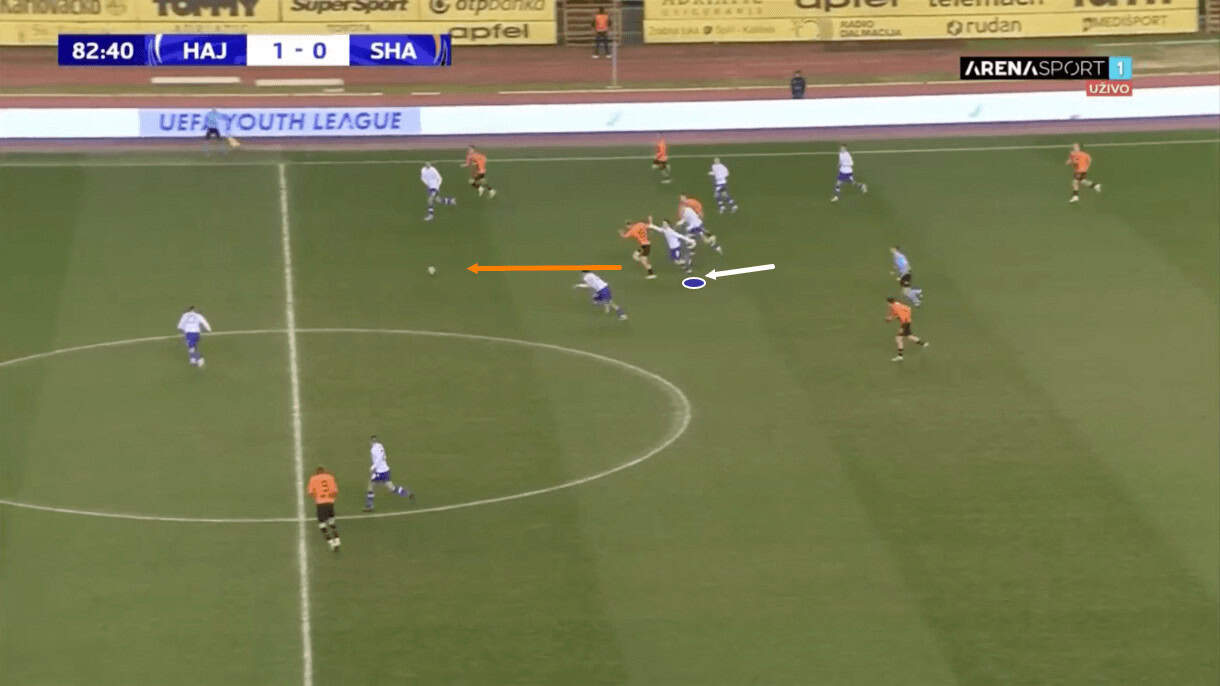
Thanks to a neat one-two, as we move on into figure 10, we can see that the opposition progressed beyond this player and began storming towards Hajduk’s half of the pitch to exploit the space that’s opened up. However, the attack grinds to an unceremonious halt as the player tracking back who’s followed this runner for some time nicks the player and does just enough to throw him off-balance, conceding a free-kick but also buying his team time to regroup and add sufficient padding to their defence once again, which was looking endangered not so much prior.
You can argue about the morality of such actions but what’s clear is that Hajduk’s players defend with great commitment and energy, with a clearly engrained mentality to keep fighting for the ball until it’s regained, not just until it’s someone else’s problem. There’s evidently a great team spirit within Budimir’s collective, which has played an important part in the team’s success under the 42-year-old coach.
Conclusion
To conclude our tactical analysis, we hope we’ve clearly defined and showcased some of the key aspects of Budimir’s pressing approach with Hajduk Split U19s that’s been so successful throughout his tenure with the team. Their clash with Manchester City should be a hotly-contested tie but regardless of what comes of it, we feel there’s a lot more to come from Budimir in football management, with his time as Hajduk Split U19s boss potentially acting as a great launchpad into the senior game.

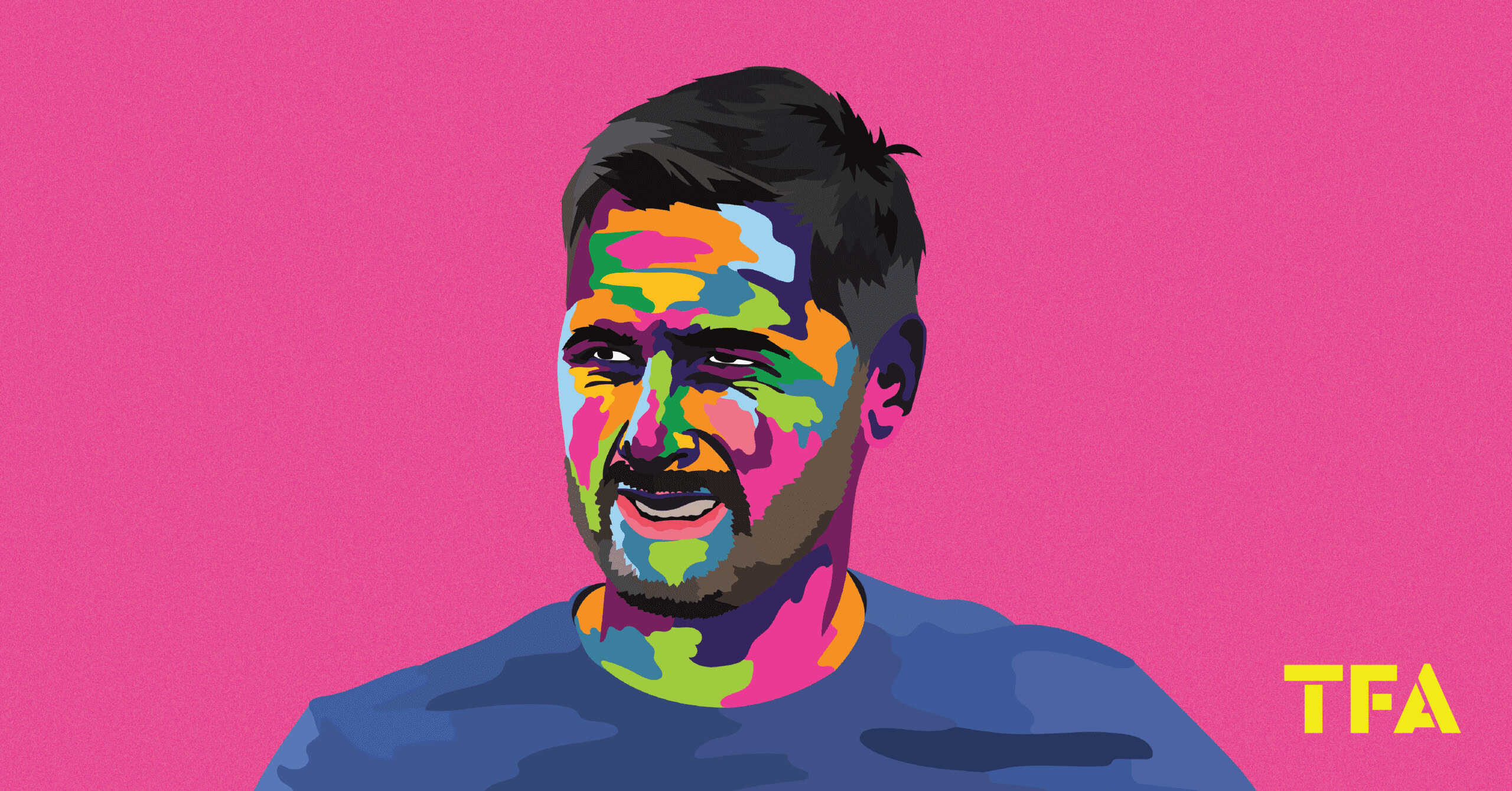



Comments